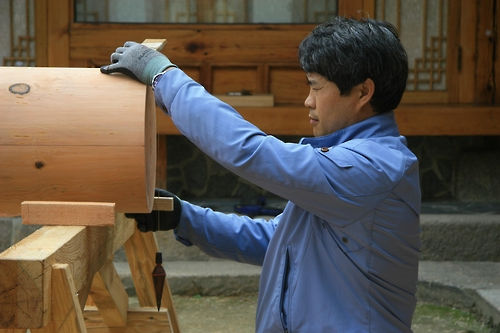(Yonhap Interview) Master carpenter of 26 years calls for training more 'hanok' experts
- Youngil Kihm
- 2016년 11월 10일
- 3분 분량
Life hasn't been kind to Jung Tae-do. His mother died when he was merely 2 years old. His father passed away when he was 11.
The responsibility of taking care of the family and putting food on the table fell on the young Jung and his grandmother. He alternately went to school and scoured mountains to pick up something to eat or sell, like medicinal herbs and acorns. Unsurprisingly, he dropped out of high school. He started learning carpentry from his uncles.
Now, the struggling young boy has become one of the most skilled carpenters in the country when it comes to building "hanoks," Korean traditional houses with tilted roofs and wooden-slat windows, which are rapidly being replaced by glitzy, modern buildings and apartments.

In this undated photo provided by Jung Tae-do, he judges a piece of lumber that is to be used for "hanok" construction. (Yonhap)
Since this year, Jung's been working at the Seoul Hanok Center run by the city government to provide professional counseling and support for people who live or are considering living in the traditional houses. The center also runs various participatory programs to educate people on the basic structure and characteristics of the houses and how to maintain them.
While he welcomes the city's efforts to revive people's interest in hanok and encourage them to build and live in the traditional houses by offering financial incentives, one of the more urgent things to do is to train skilled carpenters, he said.
"I know there are several dozens of hanok schools nationwide. But with a few months of training, they can only produce an on-site manager, not an expert who can get the job done," Jung told Yonhap News Agency in a recent interview.
"I think the central government should step in to establish a training system where we can produce more professional, skilled workers," he added, citing an example that during the Joseon Dynasty (1392-1910), master artisans and craftsmen belonged to a government agency because a country's power was determined by their skills.

In this undated photo provided by Jung Tae-do, he works on the roof of a hanok under construction. (Yonhap)
Born in Hapcheon, South Gyeongsang Province, he moved to Seoul in 1988. He learned cutting and shaping doors and furniture, and did some interior-related work. One day, he watched a documentary about Shin Eung-soo, one of Korea's three carpenters who are designated as an important intangible cultural asset.
He knew at that moment he wanted to do something more professional and with a purpose. He found palace-related works, specializing in fixing old, cracked wooden structures like pillars and rafters. Soon he was acknowledged in the field for his skills and dedication. He was accepted by Shin to be his apprentice for the next 11 years, eligible for financial support from the Cultural Heritage Administration.
Before working for the city, he went around the country to build large-scale, luxurious hanoks and temples and maintain cultural heritages.
Building a hanok is much more expensive than an ordinary house, mostly because every process of the construction is done manually -- from selecting to cutting and assembling the wood -- not to mention the cost of good lumber. It didn't take long before he realized people want to build hanoks without thinking carefully about the construction cost.
"It is similar to craving luxury items. Many people want things that go far beyond their financial means and in the end they settle for fake ones. Here the fake ones would be poorly constructed hanoks," he said.
With the city government, he hopes to educate people so that they have a better understanding of the traditional architecture and ultimately train those who are interested in building a house on their own.
"Life's been harsh since when I was little. It would make me feel better to know that I came to this world for a reason, and my life, however difficult it was, was worth having lived," he said.

In this undated photo provided by Jung Tae-do, he works with a colleague to assemble wooden pieces to build a hanok. (Yonhap)
By Woo Jae-yeon jaeyeon.woo@yna.co.kr SEOUL, Nov. 10 (Yonhap)
http://m.yna.co.kr/mob2/en/contents_en.jsp?cid=AEN20161110007900315&site=0800000000&mobile




























![[tbs TV 시시각각] ‘전통의 美’ 서울 한옥 지원책에 대해](https://static.wixstatic.com/media/c24ab2_457e172bb77f4af4be79fb42c6ab0d4f~mv2_d_2216_1232_s_2.png/v1/fill/w_440,h_250,fp_0.50_0.50,q_35,blur_30,enc_avif,quality_auto/c24ab2_457e172bb77f4af4be79fb42c6ab0d4f~mv2_d_2216_1232_s_2.webp)
![[tbs TV 시시각각] ‘전통의 美’ 서울 한옥 지원책에 대해](https://static.wixstatic.com/media/c24ab2_457e172bb77f4af4be79fb42c6ab0d4f~mv2_d_2216_1232_s_2.png/v1/fill/w_74,h_42,fp_0.50_0.50,q_95,enc_avif,quality_auto/c24ab2_457e172bb77f4af4be79fb42c6ab0d4f~mv2_d_2216_1232_s_2.webp)










![[참우리건축사사무소 신입사원 채용공고]](https://static.wixstatic.com/media/c24ab2_9346cb401cc641cc9581e3da074745c0~mv2.jpg/v1/fill/w_440,h_250,fp_0.50_0.50,q_30,blur_30,enc_avif,quality_auto/c24ab2_9346cb401cc641cc9581e3da074745c0~mv2.webp)
![[참우리건축사사무소 신입사원 채용공고]](https://static.wixstatic.com/media/c24ab2_9346cb401cc641cc9581e3da074745c0~mv2.jpg/v1/fill/w_74,h_42,fp_0.50_0.50,q_90,enc_avif,quality_auto/c24ab2_9346cb401cc641cc9581e3da074745c0~mv2.webp)



댓글